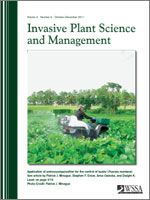A survey of the Maine landscape and nursery industry was conducted to identify industry views on invasive plant issues, attitudes towards potential regulation, and to estimate the potential economic costs of banning the sale of specific invasive plant species in Maine. Analysis of the 190 surveys returned (19% of 980 mailed) revealed that 76% of industry member respondents were genuinely concerned about invasive plant issues, and the same percentage felt the horticulture industry is responsible for educating customers about invasive plants. Industry members (68%) did not feel compelled to sell invasive plants merely on the basis of customer attraction to the plant, or due to competition with a neighboring business that sells the invasive plant. Self-reporting of sales indicated that Norway maple ($96K), burningbush ($68K), and Japanese barberry ($44K) constituted the largest portion of annual industry revenue (maximum values reported for 2006 to 2008) derived from the sale of seven identified invasive plants. Industry self-regulation was the most favored form of regulation, although the industry likely would not be significantly affected by legislated state-wide bans of at least purple loosestrife and oriental bittersweet. Bans on other popular invasive plants, including burningbush, Japanese barberry, and Norway maple likely would have a relatively small, short-term impact on the horticulture industry until alternative plants with similar properties were identified. The results of this survey demonstrated a need for identifying which plants are truly invasive or potentially invasive in Maine, as well as a need for open discussion of invasive plant issues among all interested parties in Maine.
Nomenclature: Burningbush, Euonymus alatus (Thunb.) Siebold; Japanese barberry, Berberis thunbergii DC.; Japanese honeysuckle, Lonicera japonica Thunb.; multiflora rose, Rosa multiflora Thunb.; Norway maple, Acer platanoides L.; oriental bittersweet, Celastrus orbiculatus Thunb.; purple loosestrife, Lythrum salicaria L.
Interpretive Summary: A survey of Maine landscape and nursery industry members was conducted to obtain information regarding industry views on invasive plant issues, opinions about invasive plant regulatory methods, and to identify the potential economic impact the industry would incur if invasive plant sales were banned. Survey results will assist policymakers, research investigators, and industry members in making educated decisions regarding invasive plant regulation in Maine. Industry self-regulation was the most popular form of regulation among landscape and nursery professionals, although the industry likely would not be significantly affected by legislated state-wide bans of at least purple loosestrife and oriental bittersweet. Bans on other popular invasive plants including burningbush, Japanese barberry, and Norway maple likely would have a relatively small, short-term impact on the horticulture industry until alternative plants with similar properties are identified. Data from this survey also highlight some of the apparent contradictions between the industry survey responses and what action currently is being taken by industry professionals to reduce invasive plant distributions, as illustrated by the following: (1) If customer satisfaction and/or business competition is not driving the selection of stock plants, what is the motivation for stocking and selling an invasive plant? (2) If industry professionals are willing to label potentially invasive plants, why is this not being done already? and (3) What is the level of efficacy or compliance the industry members perceive as the goal for self-regulation and what do they think is the best way to monitor participation? Future research is needed to identify motivations of industry members who knowingly sell invasive plants, what sources





